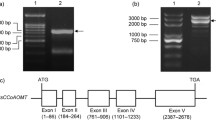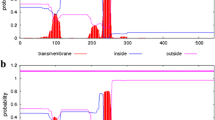Abstract
The immunoscreening method was used to isolate cDNAs of 1323 bp (ClOCT1) and 1433 bp (ClOCT2) encoding two ornithine carbamoyltransferases (OCT, EC 2.1.3.3) from the cDNA expression library ofCanavalia lineata leaves constructed in a λZAP Express vector. ClOCT1 and ClOCT2 encode 359 and 369 amino acids, respectively. The N-terminals of deduced amino acid sequences of the two cDNAs showed typical features of the transit peptide of chloroplast targeting proteins. The ornithine-binding domain (FMHCLP) and catalytic domain (HPXQ) of ClOCT1 and ClOCT2 and the carbamoyl phosphate (CP)-binding site of ClOCT1 (SMRTR) are identical to OCTs of other plant species, pea and Arabidopsis thaliana. However, the CP-binding site sequence of ClOCT2, SLRTH, has not yet been reported. Both ClOCT1 and ClOCT2 cDNAs were expressed in Escherichia coli BL21 (DE3) by using expression vector pET30a. Recombinant ClOCT1 protein showed 14 times higher ornithine-dependent OCT activity than canaline-dependent OCT activity. In contrast, recombinant ClOCT2 protein showed 13 times higher canaline-dependent OCT activity than ornithine-dependent OCT activity. The two amino acids of the CP-binding site of ClOCT2 (SLRTH) were combinatorially changed to those of the CP-binding site of ClOCT1 (SMRTR) by site-directed mutagenesis. When Leu-118 of ClOCT2 was changed to Met, ornithine-dependent activity was increased significantly. It is assumed that the substrate specificity of ClOCT1 or ClOCT2 proteins partially depends on the amino acid sequence of the CP-binding site.
Similar content being viewed by others
References
Birdsong, B.A., Alston, R. and Turner, B.L. 1960. Distribution of canavanine in the family Leguminosae as related to phyletic groupings. Can. J. Bot. 38: 499–505.
Bollag, D.M. and Edelstein, S.J. 1991. Protein Methods. Wiley-Liss, New York.
Bradford, M.M. 1976. A rapid and sensitive method for the quantitation of microgram quantities of protein utilizing principle of protein-dye binding. Anal. Biochem. 72: 248–254.
De Gregorio, A., Risitano, A., Capo, C., Crinio, C., Petruzzelli, R. and Desideri, A. 1999. Evidence of carbamoylphosphate induced conformational changes upon binding to human ornithine carbamoyltransferase. Biochem. Mol. Biol. Int. 47: 965–970.
Eid, S., Waly, Y. and Abdelal, A.T. 1974. Separation and proper-ties of two ornithine carbamoyltransferase from Pisum sativum seedlings. Phytochemistry 13: 99–102.
Glenn, E. and Maretzki, A. 1977. Properties and subcellular distribution of two partially purified ornithine transcarbamoylases in cell suspension of sugarcane. Plant Physiol. 60: 122–126.
Goldsmith, J.O., Lee, S., Zambidis, I. and Kuo, L.C. 1991. Control of L-ornithine specificity in Escherichia coli ornithine transcarbamoylase. Site-directed mutagenic and pH studies. J. Biol. Chem. 266: 18626–18634.
Huygen, R., Crabeel, M. and Glansdorff, N. 1987. Nucleotide se-quence of the ARG3 gene of the yeast Saccharomyces cerevisiae encoding ornithine carbamoyltransferase. Comparison with other carbamoyltransferases. Eur. J. Biochem. 166: 371–377.
Hwang, I.D., Lee, Y., Kim, S.G. and Kwon, Y.M. 1996. Enzyme activities of canavanine metabolism in Canavalia lineata L. callus. J. Plant Physiol. 149: 494–500.
Itoh, Y., Soldati, L., Stalon, V., Falmagne, P., Terawaki, Y., Leisinger, T. and Haas, D. 1988. Anabolic ornithine carbamoyltransferase of Pseudomonas aeruginosa: nucleotide sequence and transcriptional control of the arg F structural gene. J. Bact. 170: 2725–2734.
Kalousek, F., Orsulak, M.D. and Rosenberg, L.E. 1984. Newly processed ornithine transcarbamylase subunits are assembled to trimers in rat liver mitochondria. J. Biol. Chem. 259: 5392–5395.
Karlin-Neumann, G.A. and Tobin, E.M. 1986. Transit peptides of nuclear-encoded chloroplast proteins share a common amino acid framework. EMBO J. 5: 9–13.
Keegstra, K., Olsen, L.J. and Theg, S.M. 1989. Chloroplastic precursors and their transport across the envelope membranes. Annu. Rev. Plant Physiol. 40: 471–501.
Kraus, J.P., Hodges, P.E., Williamson, C.L., Horwich, A.L., Kalousek, F., Williams, K.R. and Rosenberg, L.E. 1985. A cDNA clone for the precursor of rat mitochondrial ornithine tran-scarbamylase: comparison of rat and human leader sequences and conservation of catalytic sites. Nucl. Acids Res. 13: 943–952.
Kuo, L.C., Miller, A.W., Lee, S. and Kozuma, C. 1988. Site-directed mutagenesis of Eschericha coli ornithine transcarbamoylase: Role of arginine-57 in substrate binding and catalysis. Biochemistry 27: 8823–8832.
Kuo, L.C., Caron, C., Lee, S. and Herzberg, W. 1990. Zn 2 +regulation of ornithine transcarbamoylase. II. Metal binding site. J. Mol. Biol. 211: 271–280.
Laemmli, U.K. 1970. Cleavage of structural proteins during the assembly of the head of bacteriophage T4. Nature 227: 680–685.
Langley, D.B., Templeton, M.D., Fields, B.A., Mitchell, R.E. and Collyer, C.A. 2000. Mechanism of inactivation of ornithine transcarbamoylase by N-delta-(N′-sulfodiaminophosphinyl)-L-ornithine: a true transition state analogue? Crystal structure and implications for catalytic mechanism. J. Biol. Chem. 275: 20012–20019.
Lee, Y. and Kwon, Y.M. 2000. Identification of an isoform of ornithine carbamoyltransferase that can effectively utilize canaline as a substrate from the leaves of Canavalia lineata. Plant Sci. 151: 145–151.
Lee, Y., Lee, C.B., Kim, S-G. and Kwon, Y.M. 1997. Purification and characterization of ornithine carbamoyltransferase from the chloroplasts of Canavalia lineata leaves. Plant Sci. 122: 217–224.
Lee, Y., Jun, B.O., Kim, S-G. and Kwon, Y.M. 1998. Purification of ornithine carbamoyltransferase from kidney bean (Phaseolus vulgaris L.) leaves and comparison of the properties of the enzyme from canavanine-containing and-deficient plants. Planta 205: 375–379.
Melangeli, C., Rosenthal, G.A. and Dalman, D.L. 1997. The biochemical basis for L-canavanine tolerance by tobacco budworm Heliothis virescens (Noctuidae). Proc. Natl. Acad. Sci. USA 94: 2255–2260.
Miller, A.W. and Kuo, L.C. 1990. Ligand-induced isomerization of Escherichia coli ornithine transcarbamoylase. An ultraviolet difference analysis. J. Biol. Chem. 265: 15023–15027.
Moore, A.L., Wood, C.K. and Watts, F.Z. 1994. Protein import into plant mitochondria. Annu. Rev. Plant Physiol. 45: 545–575.
Nakai, K. and Kanehisa, M. 1992. A knowledge base for prediction protein localization sites in eukaryotic cells. Genomics 14: 897–911.
Natelson, S., Koller, A., Tseng, H., Dods, R.F. 1977. Canaline carbamoyltransferase in human liver as part of a metabolic cycle in which guanidino compounds are formed. Clin. Chem. 23: 960–966.
O'Neal, T.D. 1975. Invitro synthesis of ureidohomoserine by an enzyme from jack bean (Canavalia ensiformis) leaves. Plant Physiol. 55: 975–977.
Quesada, V., Ponce, M.R. and Micol, J.L. 1999. OTC and AUL1, two convergent and overlapping genes in the nuclear genome of Arabidopsis thaliana. FEBS Lett. 461: 101–106.
Rosenthal, G.A. 1977. Nitrogen allocation for L-canavanine synthesis and its relationship to chemical defense of the seed. Biochem. Syst. Ecol. 5: 219–220.
Rosenthal, G.A. 1992. Purification and characterization of the higher plant enzyme L-canaline reductase. Proc. Natl. Acad. Sci. USA 89: 1780–1784.
Sambrook, J., Fritsch, E.F. and Maniatis, T. 1989. Molecular Cloning: A Laboratory Manual, 2nd ed. Cold Spring Harbor Laboratory Press, Plainview, NY.
Sanger, F., Nicklen, S. and Coulson, A.R. 1977. DNA sequencing with chain termination inhibitors. Proc. Natl. Acad. Sci. USA 74: 5463–5467.
Shi, D., Morizono, H., Ha, Y., Aoyagi, M., Tuchman, M. and Allewell, N.M. 1998. 1.85-Å Resolution crystal structure of human ornithine transcarbamoylase complex with N-phosphonoacetyl-L-ornithine. Catalytic mechanism and correlation with inherited deficiency. J. Biol. Chem. 273: 34247–34254.
Slocum, R.D. and Richardson, D.P. 1991. Purification and char-acterization of ornithine transcarbamylase from pea (Pisum sativum L.). Plant Physiol. 96: 262–268.
Slocum, R.D., Nichols, H.F. and Williamson, C.L. 2000. Purification and characterization of Arabidopsis ornithine transcarbamoylase (OTCase), a member of a distinct and evolutionarily conserved group of plant OTCases. Plant Physiol. Biochem. 38: 279–288.
Spencer, P.W. and Titus, J.S. 1974. The occurrence and nature of or-nithine carbamoyltransferase in senescing apple leaf tissue. Plant Physiol. 54: 382–385.
Swofford, D.L. 1993. PAUP: Phylogenetic analysis using parsimony, ver. 3.1.2. Illinois Natural History Survey, Champaign, IL.
Wild, J.R. and Wales, M.E. 1990. Molecular evolution and genetic engineering of protein domains involving aspartate transcarbamoylase. Annu. Rev. Microbiol. 44: 193–218.
Williamson, C.L., Lake, M.R. and Slocum, R.D. 1996. Isolation and characterization of a cDNA encoding a pea ornithine transcarbamoylase (argF) and comparison with other transcarbamoylases. Plant Mol. Biol. 31: 1087–1092.
Yu, G.H. and Kwon, Y.M. 1992. Alteration of arginase activity in leaf protoplasts of Canavalia lineata. Korean Biochem. J. 25: 196–202.
Author information
Authors and Affiliations
Rights and permissions
About this article
Cite this article
Lee, Y., Choi, YA., Hwang, I.D. et al. cDNA cloning of two isoforms of ornithine carbamoyltransferase from Canavalia lineata leaves and the effect of site-directed mutagenesis of the carbamoyl phosphate binding site. Plant Mol Biol 46, 651–660 (2001). https://doi.org/10.1023/A:1011632927541
Issue Date:
DOI: https://doi.org/10.1023/A:1011632927541




